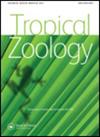巴西东北部的原始半干旱地区主要位于山脉的斜坡上:基于塞拉德桑塔纳鸟类群落的案例研究
IF 0.7
4区 生物学
Q4 ZOOLOGY
引用次数: 6
摘要
各地的原始地区越来越少,导致自然环境的碎片分散。在巴西草原稀树草原,这种情况需要引起注意,因为具有较高经济价值的栖息地在保护区系统中代表性不足。在2009年至2010年间,我们调查了60个不同景观的地点,如桑塔纳山脉的高原、斜坡和低地。在每个站点,我们采用标准化的鸟类调查方法,并比较了每个景观的观测和预测丰富度。共记录物种189种,物种丰富度以斜坡生境最高,其次为高原,其次为低地。在坡面生境中,森林依赖性物种较多,对干扰的高、中敏感性物种较多。对干扰高度和中等敏感的特有种仅限于斜坡和高原的一些碎片。结果表明,该地区鸟类物种丰富度高,存在特有种和濒危物种,是一个重要的区域。由于最近人类的占领,斜坡地区是最富饶的。作为桑塔纳山的优先措施,我们建议控制森林砍伐,并指定一个保护区,包括该地区所有的海拔变化。本文章由计算机程序翻译,如有差异,请以英文原文为准。
Pristine semi-arid areas in northeastern Brazil remain mainly on slopes of mountain ranges: a case study based on bird community of Serra de Santana
Pristine areas are becoming rare everywhere, resulting in scattered fragments of natural environments. In the Brazilian steppe savanna, this situation requires attention because habitats with higher economic value are underrepresented by the protected area system. Between 2009 and 2010, we surveyed 60 sites with differing landscapes such as plateaus, slopes, and lowlands in the Serra de Santana. At each site, we applied standardized bird survey methods and compared the observed and projected richness of each landscape. We recorded 189 species, with the highest species richness in the slope habitat, followed by plateaus, and then lowlands. In the slope habitat, there were more forest-dependent species, as well as more species with high and medium sensitivity to disturbance. Endemic species with high and medium sensitivity to disturbances were restricted to slopes and some fragments of the plateaus. Our results show that the region is an important area due to the high bird species richness and presence of endemic and threatened species. The slope areas were the richest due to more recent human occupation. As priority measures for Serra de Santana, we suggest the control of deforestation and the designation of a protected area that encompasses all the altitudinal variation in the region.
求助全文
通过发布文献求助,成功后即可免费获取论文全文。
去求助
来源期刊

Tropical Zoology
生物-动物学
CiteScore
2.50
自引率
0.00%
发文量
1
审稿时长
>12 weeks
期刊介绍:
Tropical Zoology is an international zoological journal publishing original papers in the field of systematics, biogeography, phylogeny, ecology and conservation of all terrestrial and aquatic animal Phyla from tropical and subtropical areas.
Only papers with new information, high quality and broad interest are considered. Single species description and checklists are not normally accepted. Review papers are welcome. The journal is owned by the Istituto di Ricerca sugli Ecosistemi Terrestri of the Consiglio Nazionale delle Ricerche, Florence, Italy (CNR-IRET) who performs research into the structure and functioning of aquatic and terrestrial ecosystems, focusing in particular on anthropogenic pressure and global change. The knowledge amassed forms the scientific basis for identifying the most appropriate protective and corrective interventions, and provides support for the bodies entrusted with formulating policies for environmental protection and recovery.
 求助内容:
求助内容: 应助结果提醒方式:
应助结果提醒方式:


